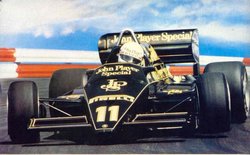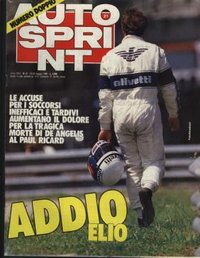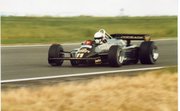Elio de Angelis
| Elio de Angelis | |
|---|---|
| Nationality | |
| Years | 1979 – 1986 |
| Team(s) | Shadow, Lotus, Brabham |
| Races | 109 (108 starts) |
| Championships | 0 |
| Wins | 2 |
| Podiums | 9 |
| Points | 122 |
| Poles | 3 |
| Fastest laps | 0 |
| First race | 1979 Argentine Grand Prix |
| First win | 1982 Austrian Grand Prix |
| Last win | 1985 San Marino Grand Prix |
| Last race | 1986 Monaco Grand Prix |
| BF1 Years | 1978 |
| BF1 Races | 1 |
| BF1 Championships | 0 |
| BF1 Wins | 0 |
| BF1 Podiums | 1 |
| BF1 Points | |
| BF1 Poles | |
| BF1 Fastest laps | 0 |
Elio de Angelis (26 March 1958 – 15 May 1986) was a racing driver who participated in Formula One between 1979 and 1986, racing for the Shadow, Lotus and Brabham teams. He was killed during testing at the Paul Ricard circuit at Le Castellet in 1986. He is sometimes referred to as Formula One's "last gentleman player," and although he was probably not the most talented driver ever, he was certainly among the most popular.
Career
De Angelis was born in Rome. His father Giulio was a notable offshore powerboat racer.
Having driven for Shadow in his debut F1 season in 1979, he switched to Lotus in 1980 and - at the age of 21 - nearly became the youngest Grand Prix winner of all time when he finished a tantalising second at the 1980 Brazilian Grand Prix at Interlagos. His first victory came in the 1982 Austrian GP at the Osterreichring, only 0.05 seconds ahead of Keke Rosberg.
He left Lotus at the end of the 1985 season when it became clear the team's efforts were being focused on his prodigiously-talented team-mate Ayrton Senna. De Angelis' replacement in the team was Johnny Dumfries, who owed his place almost entirely to the fact that he would accept being subordinate to Senna (Senna would not tolerate the much more competitive Derek Warwick as a co-driver) and that Dumfries came from a rich Scottish family. De Angelis' drive for 1986 was with Brabham - another famous name now disappeared - as a replacement for twice World Champion Nelson Piquet (Piquet had left for the Williams team because Brabham boss Bernie Ecclestone would not match his salary demands).
The 1986 Brabham-BMW, the BT55, was a radically-designed car, with a very low cross section. However, it was not effective and could not arrest Brabham's swift decline. It quickly became clear that 1986 would not be the year the team recaptured its glory days of the early 1980s. Nevertheless, de Angelis pushed his hardest to help develop the car. During tests at the Paul Ricard circuit in France, the rear wing of the BT55 came off at high speed, making the car lose downforce on the rear wheels, cartwheel over a barrier and catch fire. The impact did not kill de Angelis but, tragically, he could not get out of the car unassisted. The situation was exacerbated by the lack of marshals on the French circuit, or indeed anyone who could have assisted. A 30 minute delay ensued before an emergency helicopter arrived. De Angelis died 29 hours later in the hospital in Marseille to which he had been taken, from injuries caused by the smoke inhaled during the accident. His only other injuries were a broken collar bone and light burns on his back.
De Angelis was the last driver to die in an F1 car until Roland Ratzenberger at Imola eight years later. His place in the Brabham team was taken by Derek Warwick - allegedly because Warwick was the only unemployed F1 driver who did not contact Ecclestone immediately afterwards asking about the drive.
As well as his considerable skill as a driver, de Angelis was also concert-standard pianist who famously once kept the drivers entertained for an entire evening in the midst of the 1982 drivers' strike.
Complete Formula One World Championship results
(key) (Races in bold indicate pole position)


